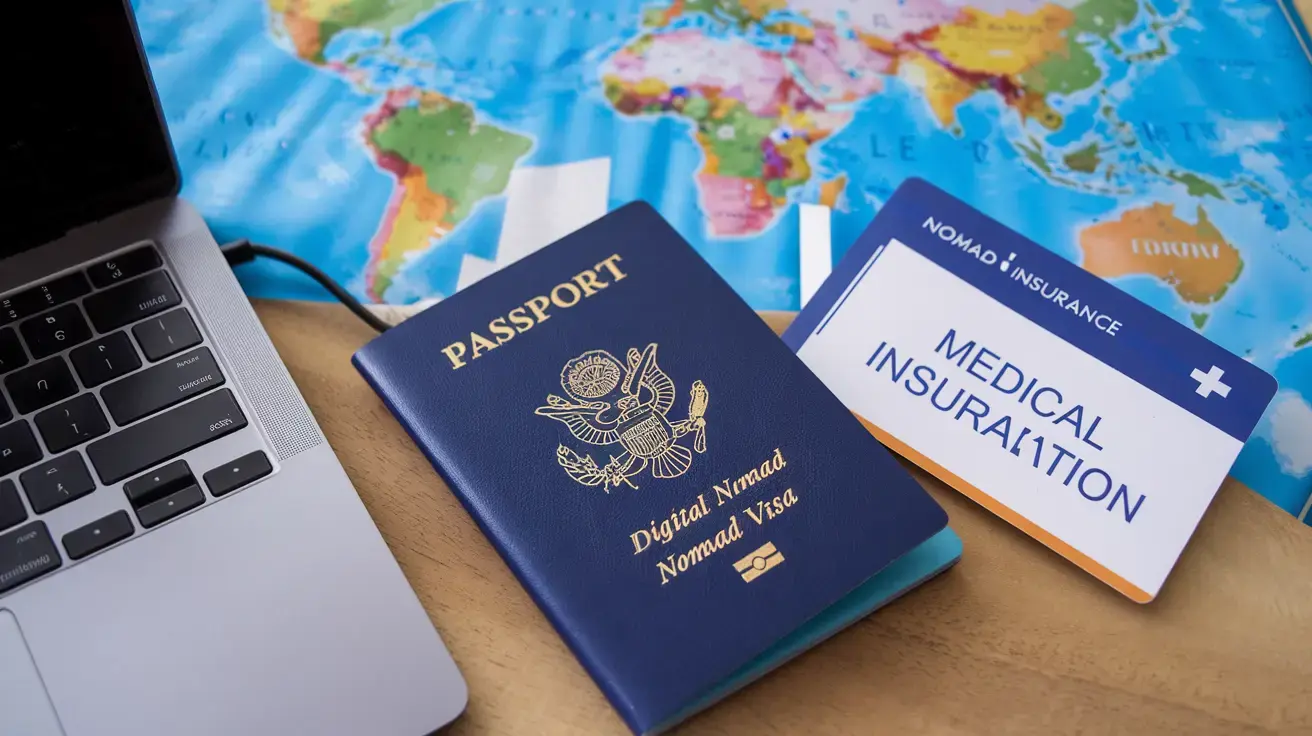Introduction: Best Countries For Digital Nomads
You’re scrolling through your Instagram feed, seeing Lisa from accounting posting sunset pics from Bali while somehow still making deadlines. Meanwhile, you’re stuck in fluorescent lighting wondering if that could be you.
It can. And I’m about to show you exactly where you should pack your laptop and head to in 2025.
The digital nomad lifestyle isn’t just a trend anymore—it’s a legitimate career move. With remote work policies solidifying across industries, choosing the right countries for digital nomads to base yourself can mean the difference between “living the dream” and “expensive mistake.”
The countries on this list aren’t just pretty places. They’ve been vetted for internet reliability, cost of living, visa flexibility, and those intangible qualities that make you want to stay longer than planned.
But which unexpected European country just launched a program that gives nomads better healthcare than most Americans get at home?
What makes a good destination for a digital nomad?
What Makes a Good Destination for a Digital Nomad?
Affordability
Living costs can make or break your nomad experience. The perfect spot balances reasonable rent, food costs, and daily expenses without draining your bank account.
In 2025, your dollar stretches much further in places like Thailand and Mexico compared to Switzerland or Norway. A comfortable apartment in Chiang Mai might cost $500 monthly, while the same setup in London could set you back $2,500+.
Smart nomads look beyond just rent. Consider these everyday expenses:
- Coffee shop work sessions (you’ll have many!)
- Transportation costs
- Eating out vs. cooking
- Coworking space memberships
- Healthcare expenses
Your income hasn’t changed just because you’re working poolside. Budget accordingly!
Safety
No Instagram-worthy sunset view is worth feeling unsafe. Personal security matters tremendously when choosing your next base.
Many nomad hotspots like Portugal, Japan, and New Zealand consistently rank among the world’s safest countries. This means:
- Walking home after dark without constant worry
- Leaving your laptop briefly unattended in a café
- Less concern about scams targeting foreigners
- Lower crime rates overall
Check travel advisories before booking flights, but also connect with other nomads who’ve actually lived there. They’ll give you the real scoop on safety beyond tourist zones.
Climate and Weather
Weather impacts your daily life and productivity more than most realize.
Some nomads chase eternal summer, hopping between hemispheres. Others prefer four distinct seasons or moderate temperatures year-round. Consider:
- Your ideal working temperature
- Rainy seasons that might trap you indoors
- Extreme weather events (hurricane seasons, monsoons)
- Seasonal allergies or health conditions affected by climate
Remember that climate change is increasingly disrupting traditional weather patterns. Research recent conditions rather than relying on outdated information.
Visa Requirements
Even paradise becomes stressful if you’re constantly watching the calendar for visa expiration.
The landscape for digital nomad visas has evolved dramatically since 2023. Countries now actively compete for remote workers with special visa programs offering:
- Legal stays of 6-24 months
- Simplified application processes
- Tax benefits
- Access to local healthcare systems
- Banking and financial services
Popular options include Portugal’s D7 visa, Spain’s digital nomad visa, and Thailand’s long-term resident visa. Each has different income requirements, application fees, and renewal processes.
Always research the most current visa information directly from official government sources. Immigration rules change frequently, and outdated blog posts can lead to serious border problems.
Top 10 countries for digital nomads

1. Portugal
Imagine waking up to the sound of the Atlantic ocean, sipping a $1 espresso at a sidewalk café, and opening your laptop with 1 Gbps internet speed. That’s Portugal for you—the digital nomad dream in 2025.
Portugal’s Digital Nomad Visa, launched in late 2022, has matured into one of the most straightforward programs globally. It allows remote workers earning at least €3,040 monthly to live in Portugal for up to two years.
The cost of living is what makes Portugal truly shine. A comfortable life in Lisbon costs around €1,500-2,000 monthly—about half what you’d spend in Paris or London. Move to smaller cities like Porto or Braga, and that number drops even further.
The infrastructure keeps improving too. Co-working spaces have popped up everywhere, from beachside setups in the Algarve to renovated historic buildings in Lisbon’s trendy neighborhoods.
What nomads really love? The genuine Portuguese welcome. The locals actually want you there, unlike some overtouristed destinations where foreigners are barely tolerated. Plus, with 300+ days of sunshine annually and some of Europe’s best beaches, your work-life balance gets the upgrade it deserves.
The cherry on top? Portugal’s central location makes weekend trips to Spain, Morocco, or anywhere in Western Europe a breeze.
2. Canada
Canada might not be the first country that comes to mind for digital nomads, but in 2025, it’s earned its spot in the top rankings for good reason.
The new Canadian Digital Nomad Stream introduced in late 2024 allows remote workers to stay for up to 2 years, provided they earn above CAD $55,000 annually. Unlike many nomad visas, this one offers a pathway to permanent residency—a major selling point for those thinking long-term.
Sure, Canada isn’t cheap. Expect to budget around CAD $2,500-3,500 monthly in cities like Toronto or Vancouver. But the trade-off? World-class healthcare access, impeccable infrastructure, and some of the cleanest cities globally.
The Canadian tech scene is booming, particularly in Toronto, Vancouver, and Montreal. This means plenty of networking opportunities, meetups, and co-working spaces designed specifically with remote workers in mind.
What separates Canada from many nomad hotspots is its genuine multiculturalism. You’ll find authentic global cuisines and cultural experiences without leaving the country. And when you need to disconnect, the stunning natural landscapes—from the Rocky Mountains to the Atlantic coastline—provide the perfect backdrop.
Winter isn’t everyone’s cup of tea, but many nomads strategically split their time—Canadian summers and fall, then somewhere warmer for winter months. With excellent international flight connections, this seasonal migration is surprisingly manageable.
3. Spain
The Spanish Digital Nomad Visa program launched in 2023 has evolved into one of Europe’s most popular by 2025, and I’m not exaggerating when I say it’s revolutionized the remote work scene across the country.
Spain’s program offers a renewable one-year visa with a relatively low income requirement of €2,000 monthly. The real kicker? A special 15% flat tax rate instead of the standard 24% or higher progressive rates—keeping more euros in your pocket.
Cost of living varies wildly. Barcelona and Madrid might set you back €2,000-2,500 monthly, but head to Valencia, Málaga, or Seville and you’ll live comfortably on €1,500-1,800. The quality of life per euro spent is off the charts.
Spain’s internet infrastructure has improved dramatically, with fiber internet now standard in most urban areas. The country has embraced its digital nomad influx with specialized co-working networks like “Nomad Spain” offering discounted rates across multiple cities.
The Spanish lifestyle is the real draw though. Late dinners, afternoon siestas, and weekend beach trips aren’t just stereotypes—they’re legitimate productivity enhancers. The work-life balance here isn’t just talked about; it’s actually practiced.
The huge expat communities in cities like Barcelona and Madrid mean you’ll never struggle to find English speakers, yet you’re still immersed in authentic Spanish culture. And with high-speed trains connecting major cities, weekend explorations are a breeze.
4. Thailand
Thailand has been digital nomad territory since before “digital nomad” was even a term, but the 2023 introduction of the proper Long-Term Resident Visa specifically for remote workers has eliminated the old visa run headaches.
The 10-year visa program requires proof of $80,000 annual income and health insurance steeper than before but worth it for the stability. The program includes work authorization, tax benefits, and fast-track services at international airports.
Bangkok remains the urban hub with its chaotic energy and ultramodern co working spaces, while Chiang Mai continues as the laid-back northern capital for nomads seeking mountain vibes. The island life on Koh Samui or Phuket attracts those who want beach living without sacrificing connectivity.
Cost of living is still Thailand’s biggest selling point in 2025. You can live very comfortably on $1,500-2,000 monthly, including a modern apartment, daily restaurant meals, and weekend excursions. Premium living with all the bells and whistles might push $3,000—still a fraction of Western costs.
The internet infrastructure keeps improving, with 5G coverage now extensive across tourist areas and fiber connections standard in most accommodations catering to remote workers.
What’s changed most in 2025 is the sustainability focus. Many Thai nomad hotspots now feature eco-coworking spaces, zero-waste cafés, and community initiatives addressing overtourism—giving conscious digital nomads ways to minimize their impact while still enjoying paradise.
5. Mexico
Mexico continues its reign as a digital nomad powerhouse in 2025, striking that perfect balance between affordability, connectivity, and lifestyle that’s hard to beat anywhere else.
The Temporary Resident Visa process has been streamlined specifically for remote workers, allowing stays of up to four years with minimal income requirements (around $2,500 monthly). Many nomads start with the six-month tourist entry and then convert to residency once they’re sure Mexico is right for them.
Mexico City remains the bustling hub with its world-class food scene and endless neighborhoods to explore, while Puerto Vallarta, Playa del Carmen, and Mérida continue drawing those seeking smaller communities with more nature access. Newcomers like San Miguel de Allende and Oaxaca City have exploded in popularity for their cultural richness.
Monthly budgets of $1,200-2,000 will get you very comfortable living in most Mexican nomad destinations, including nice accommodations, eating out regularly, and weekend adventures. The value proposition remains unmatched.
Internet connectivity has seen major improvements with Starlink now widely available even in previously challenging areas. Coworking infrastructure keeps expanding, with spaces like Selina and WeWork joined by boutique local options catering specifically to international remote workers.
The nomad community in Mexico is exceptionally strong, with regular events, mastermind groups, and skill-sharing meetups in major hubs. This built-in network makes Mexico particularly appealing for solo nomads looking for instant community.
6. Estonia
Estonia isn’t just a digital nomad destination—it’s the country that pioneered the entire concept of the digital nomad visa back in 2020. Five years later, their program remains one of the most forward-thinking globally.
The Estonian Digital Nomad Visa allows remote workers to live in this Baltic gem for up to a year, provided they earn at least €3,504 monthly. The application process is predictably digital-first—you can complete nearly everything online, reflecting Estonia’s famous e-government approach.
Tallinn, the capital, blends medieval charm with cutting-edge tech infrastructure. The Old Town’s cobblestone streets lead to ultramodern coworking spaces and cafés where seemingly everyone is building a startup or running remote teams. The startup density here rivals anywhere in Europe.
Cost of living sits in the European mid-range—expect to budget €1,500-2,000 monthly for comfortable living. While not as cheap as Southeast Asia, the quality of infrastructure, healthcare, and public services provides excellent value.
Estonia’s weather is the main drawback—winters are long and dark. But the locals have perfected the art of coziness, and summer days with nearly 19 hours of sunlight make up for the winter blues. Many nomads use Estonia as a summer base and migrate south for winter.
The nomad community here tends to be more tech-focused and entrepreneurial than in purely lifestyle destinations. If you’re looking to network with serious remote professionals rather than “digital tourists,” Estonia’s community is hard to beat.
7. Georgia
Georgia (the country, not the state) remains 2025’s ultimate under-the-radar digital nomad destination, offering a unique blend of European charm, Asian influences, and exceptional affordability.
The “Remotely from Georgia” program allows digital nomads to stay for a full year with minimal requirements—just proof of employment and a modest income of $2,000 monthly. The application takes less than 10 minutes online, and approval typically comes within 10 days.
Tbilisi, the capital, feels like a European city without European prices. The historic Old Town with its sulfur baths and ancient churches sits alongside hipster neighborhoods like Vera and Vake, packed with specialty coffee shops and coworking spaces. The food scene is mind-blowing—imagine Turkish, Persian, Russian, and Mediterranean influences all colliding.
The cost of living is what really sets Georgia apart. Comfortable living in Tbilisi runs about $800-1,200 monthly, including a nice apartment in the center, eating out regularly, and weekend trips to the mountains or Black Sea coast.
Georgia’s internet is surprisingly excellent, with fiber connections standard in most apartments and 5G widely available. The coworking infrastructure keeps expanding, with spaces like Impact Hub Tbilisi and Terminal offering world-class facilities at a fraction of Western prices.
The nomad community is tight-knit but welcoming. You’ll find a mix of entrepreneurs, freelancers, and remote employees drawn by the affordability and the chance to experience a culture that remains relatively untouched by mass tourism.
8. Indonesia (Bali)
Bali has transformed its digital nomad landscape dramatically since 2023, when Indonesia finally launched its long-awaited “Second Home Visa” program, allowing stays of 5-10 years. This eliminated the old visa run hassles that plagued the island for decades.
The visa requires proof of $130,000 in an Indonesian bank account—steep compared to other nomad visas, but the longer duration makes it worthwhile for committed Bali lovers. For those not ready for that commitment, the B211A “Social-Cultural” visa allows up to 180 days with extensions.
Canggu remains the digital nomad epicenter, though many veterans have migrated to Ubud, Uluwatu, or emerging spots like Amed to escape the crowds. Each area offers distinct vibes—beach party in Canggu, spiritual jungle in Ubud, cliff-top luxury in Uluwatu.
Monthly budgets of $1,500-2,500 provide very comfortable living in most areas, including villa accommodation (often with private pools), daily dining out, and scooter rental. The value proposition remains outstanding despite rising prices.
Internet connectivity has improved dramatically, with fiber now standard in nomad areas and Starlink available island-wide. Coworking spaces have evolved beyond basic desks to become full lifestyle hubs with pools, cafés, fitness centers, and networking events.
Bali’s nomad scene is unmatched for community. Whatever your interest—cryptocurrency, wellness, spirituality, surfing, marketing—you’ll find ready-made groups of like-minded professionals. This built-in network remains Bali’s biggest advantage over emerging competitors.
9. United Arab Emirates (Dubai)
Dubai has aggressively positioned itself as the luxury option in the digital nomad market, and by 2025, it’s paying off with an influx of high-earning remote professionals.
The one-year remote work visa requires proof of $5,000 monthly income—higher than most countries but reflective of Dubai’s premium positioning. The process is streamlined, typically taking less than two weeks with minimal paperwork.
What you get for this higher barrier to entry is impressive: world-class infrastructure, exceptional safety, tax-free income, and an ultra-modern city designed for convenience. The WiFi is blazing fast, power never goes out, and everything just works—a luxury not always found in more affordable nomad destinations.
Cost of living is undeniably high. Expect to budget $2,500-4,000 monthly for comfortable living, including accommodation in popular areas like Marina or Downtown, occasional taxis, and regular dining out. Summer months (May-September) offer significant discounts as locals and tourists flee the extreme heat.
The coworking scene has exploded, with options ranging from corporate-style WeWork spaces to boutique concepts like A4 Space and The Workshop. Many luxury hotels now offer “workcation” packages with dedicated workspaces and business services.
The nomad community skews older and more established than in budget destinations like Bali or Chiang Mai. You’ll meet fewer backpacker-style freelancers and more remote executives, established entrepreneurs, and high-earning specialists.
10. Hungary
Hungary might be the most surprising entry on this list, but Budapest has quietly become Europe’s best-value digital nomad destination in 2025.
The “White Card” residency permit introduced in 2024 allows remote workers earning at least €2,000 monthly to live in Hungary for up to two years. The application process is straightforward, with processing times averaging just three weeks.
Budapest offers the perfect middle ground between Western and Eastern Europe—the stunning architecture and cultural scene of Paris or Vienna at literally half the price. The city straddles the Danube River, with historic Buda on one side and energetic Pest on the other, connected by iconic bridges.
The cost of living is Budapest’s biggest draw. Comfortable living runs about €1,200-1,800 monthly, including a well-located apartment, public transportation, and regular dining out. That’s roughly 40-50% less than Berlin or Amsterdam for comparable lifestyle.
The city’s thermal bath culture offers a unique perk for remote workers—imagine finishing your workday with a soak in hundred-year-old thermal pools under ornate architecture. It’s the perfect antidote to digital burnout.
The nomad infrastructure keeps improving, with coworking spaces like Kaptar and KAPTÁR offering beautiful facilities in historic buildings. The café culture is strong, with countless spots offering excellent coffee, reliable WiFi, and laptop-friendly setups.
The international community is sizeable but not overwhelming. You’ll find enough fellow nomads for networking but plenty of opportunities to interact with locals and experience authentic Hungarian culture.
Conclusion
The world of digital nomadism continues to evolve at breakneck speed. As we’ve explored, 2025 offers more options than ever for location-independent professionals seeking their ideal home base.
Whether you’re drawn to Portugal’s coastal charm, Thailand’s affordability, or Canada’s stability, the perfect destination ultimately depends on your personal preferences, work style, and lifestyle priorities.
The most successful digital nomads aren’t just chasing the cheapest cost of living or fastest WiFi. They’re strategically selecting countries that align with their professional goals, visa situations, and quality of life needs.
As remote work becomes increasingly mainstream, countries are competing harder than ever for your laptop-carrying presence. This means better visa options, improved digital infrastructure, and more welcoming communities.
Don’t rush your decision. Take time to research thoroughly, connect with other nomads, and perhaps try short stays before committing to longer periods. Your ideal digital nomad destination might not even be on this list – the beauty of this lifestyle is discovering what works uniquely for you.
Whatever destination you choose, remember that the digital nomad journey isn’t just about where you go, but how you grow through the experience of living and working across borders.
Related Articles
- How to Maintain Productivity as a Digital Nomad: 7 Battle-Tested Strategies
- The Digital Nomad Tax Guide: Understanding Your Obligations in 2025
- Co-living Spaces vs. Private Rentals: What Works Best for Nomads?
- Nomad-Friendly Banking: Managing Your Finances Across Borders
- Building Community on the Road: Overcoming Loneliness as a Digital Nomad
- The Ultimate Digital Nomad Packing List for 2025











